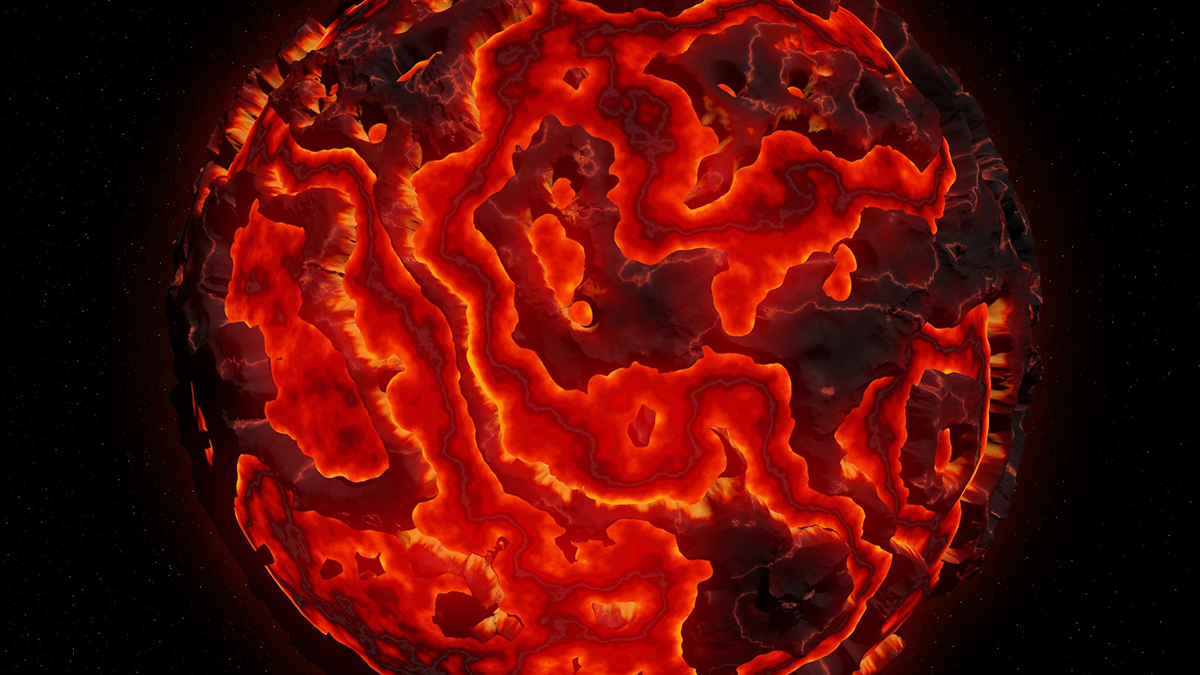Off the northeastern coast of Australia, reefs stud the often shallow Coral Sea, home to the Great Barrier Reef. Nearly 2,900 kilometers below this maritime menagerie, an unusual feature sits at the boundary between Earth’s iron-rich core and its mostly solid mantle—an ultralow-velocity zone, aptly named because it has very low seismic velocities along with higher density relative to mantle material at similar depths.
Such low velocities could hint at a partially melted, possibly iron-enriched mantle. However, an international team of researchers led by Surya Pachhai, a postdoctoral fellow at the University of Utah, argued in a new study in Nature Geoscience that this particular seismic wave–slowing splotch contains layers that represent ancient remnants of early Earth’s history, when the globe may have been covered by a different kind of ocean—one of magma that extended to the core-mantle boundary.
Seismic Treasure Under the Sea
Ultralow-velocity zones at the core-mantle boundary were first recognized nearly 30 years ago but remain enigmatic in part because scientists cannot collect physical samples, said Mike Thorne, a seismologist at the University of Utah and a study coauthor. Instead, earthquakes produce certain seismic waves called ScP waves that penetrate great depths before bouncing off the core-mantle boundary, back toward only those seismic stations located relatively close to the epicenter. “We can directly infer some of [the ultralow-velocity zone’s] properties through [these] seismic waves,” he said.
The Coral Sea happens to sit above one of the best resolved of these wave-slowing zones. To the east, between New Zealand and Tonga, the old, cold Pacific plate plunges westward, deep into the mantle, where earthquakes inevitably rupture some hundred kilometers or more below the surface. As seismic waves emanate toward the core-mantle boundary, they skip the complexity of Earth’s crust on the way down, said Thorne.
The proximity between these earthquakes and seismic stations in Australia results in the “perfect geometry” for capturing ScP waves, Thorne said, which reflect back at higher frequencies and shorter wavelengths than other seismic waves, containing precious details that longer-wavelength signals would miss.
Zooming In
A seismogram collected from a single station during a single earthquake is insufficient.
Of 1,282 earthquakes that originated near Tonga, Fiji, and Vanuatu between 2001 and 2014, Pachhai and his colleagues whittled the number to 10. They eliminated earthquakes shallower than 80 kilometers to avoid the crust, kept those with magnitudes between 5.0 and 6.5, and used other criteria to ensure only the highest-quality data.
Nevertheless, a seismogram collected from a single station during a single earthquake is insufficient to study ultralow-velocity zones. Instead, Pachhai and his colleagues stacked several seismograms as a way to improve the signal, relative to the noise. They stacked data from between 20 and 25 stations clustered together to ensure that the measured waves bounced off the same structure at the core-mantle boundary, said Pachhai.
Armed with their svelte set of stacked seismic waveforms, they turned to software that can compute synthetic seismograms to compare them to the real, stacked recording, said Thorne.
Previous studies in the region modeled this ultralow-velocity zone as a single layer with a velocity gradient, said John Hernlund, a planet scientist at the Tokyo Institute of Technology who was not involved in this study.
In Pachhai’s study, researchers varied not only parameters like density, thickness, and seismic velocities but also the number of layers within the ultralow-velocity zone. By randomly changing these parameters within a reasonable range of values and comparing the resulting synthetic seismograms with the real thing many thousands of times, they were able to create histograms of each model parameter. Hazy histograms meant that the models couldn’t constrain the causes of the wiggles on the true stacked seismic waveform, said Pachhai. Sharp, focused histograms, which showcased layers between 2 and 10 kilometers thick, meant that the models matched the measured wiggles, yielding a robust result.
According to their analysis, said Thorne, “this particular feature…has to have this layered structure to be able to explain the seismic waveforms that are passing through it.”
A Global Magma Ocean
As planetesimals collided in the early solar system, Earth began to coalesce. Iron and other dense elements sank to the nascent core. “Iron is very dense,” said Hernlund. “[When] it goes down, it doesn’t want to come back up.”
Scientists strongly suspect that a Mars-sized object careened into early Earth about 4.5 billion years ago, creating the Moon and melting the mantle into a massive mix of molten rock, gas, and crystals suspended in the magma, said Pachhai. As this global magma ocean began to cool, dense materials would have sunk, layer by layer, to the core-mantle boundary. Geodynamic models run by coauthor Mingming Li, a geodynamicist at Arizona State University, showed how these dense layers could survive the churning convection that mixed much of the mantle.
“[Ultralow-velocity zones] have a story to tell, a very important one that goes back to before the Earth was even a planet.”
If the magma ocean hypothesis is correct, remnants of early Earth’s chemical heterogeneities still exist, 4.5 billion years later. One way to test this is to look at other ultralow-velocity zones in similarly exquisite detail, said Thorne. If layering is common to these features, he said, “then a good way to generate them is through this…magma ocean concept.”
“Personally, I would look to partial melt as a natural cause, coupled with composition variations,” Hernlund demurred, though he was among the first to propose that these features could stem from dense leftovers of a magma ocean.
“[Ultralow-velocity zones] have a story to tell,” said Hernlund, “a very important one that goes back to before the Earth was even a planet.”
—Alka Tripathy-Lang (@DrAlkaTrip), Science Writer

